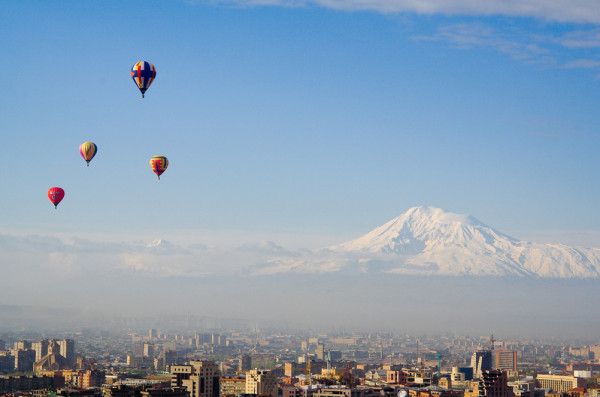Price: 315 $
Period: 5 days
Price per person for single room
450 $
Price per person for double room
330 $
Price per person for triple room
315$
Day 2 / Yerevan City tour, The Monument Mother Armenia, Cascade complex, Northern Avenue, Republic Square, Megeryan Carpet Factory
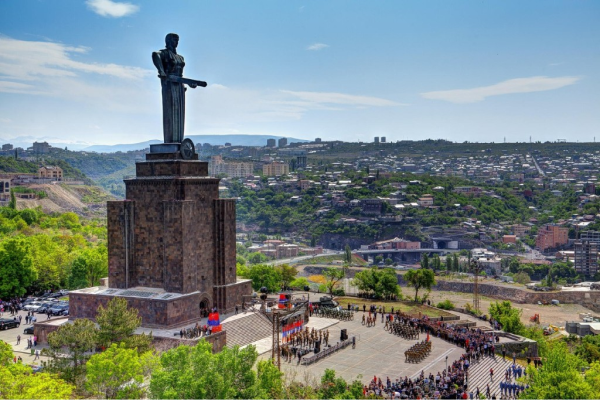
The Mother Armenia Memorial Complex was opened in 1967, in Victory Park. The height of the monument is 52 meters and the statue’s height is 22 meters. Initially, there was Joseph Stalin’s monument which was unveiled in 1950 and removed in 1962. After 5 years from its removal, the statue “Mother Armenia” was erected.
The author, the famous architect Rafael Israelyan, designed the pedestal in the style of Armenian three-nave Basilica church. The statue of a woman holds a sword with both hands. Her prototype was a 17-year-old girl Evgenia Muradyan, whom the sculptor Ara Harutyunyan saw in the store and persuaded to pose for the statue.
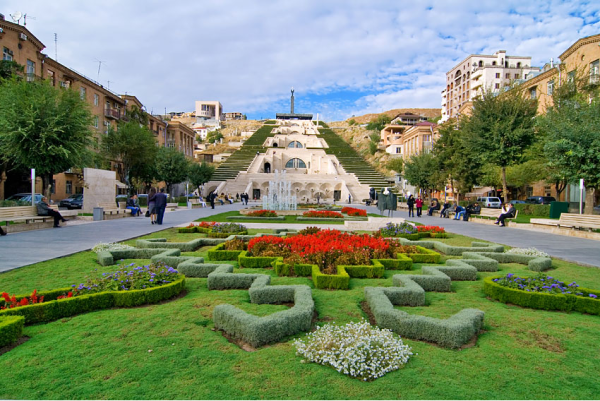
The Cascade complex The building that now houses the Cafesjian Center for the Arts is well known to the Armenian people, especially those living in its capital city of Yerevan. Known as “The Cascade,” the complex was originally conceived by the architect Alexander Tamanyan (1878–1936). Tamanyan desired to connect the northern and central parts of the city—the historic residential and cultural centers of the city—with a vast green area of waterfalls and gardens, cascading down one of the city’s highest promontories. Unfortunately, the plan remained largely forgotten until the late 1970s, when it was revived by Yerevan’s Chief Architect, Jim Torosyan. Torosyan’s conception of the Cascade included Tamanyan’s original plan but incorporated new ideas that included a monumental exterior stairway, a long indoor shaft containing a series of escalators, and an intricate network of halls, courtyards, and outdoor gardens embellished with numerous works of sculpture bearing references to Armenia’s rich history and cultural heritage.
Construction of Torosyan’s design of the Cascade was launched by the Soviets in the 1980s but abandoned after the Armenian earthquake of 1988 and the break-up of the Soviet Union in 1991. With independent rule and the transition to democracy, Armenia entered a period of severe economic hardship, and the Cascade remained a neglected relic of the Soviet era for more than a decade. Mr. Cafesjian, working with the City of Yerevan and the government of the Republic of Armenia, initiated its recent revitalization in 2002. Over the next seven years, virtually every aspect of the monument was renovated, and much of it completely reconstituted into a Center for the Arts bearing the name of its principal benefactor.
Cascade Statistics
Number of steps – 572
Distance from the bottom to the top of the Cascade: 302 m / 991 feet
Distance from the bottom to the top of the Monument Terrace: 450 m / 1476 feet
Width: 50 m / 164 feet
Height of Monument Terrace: 118 m / 387 feet
Incline: 15 degrees
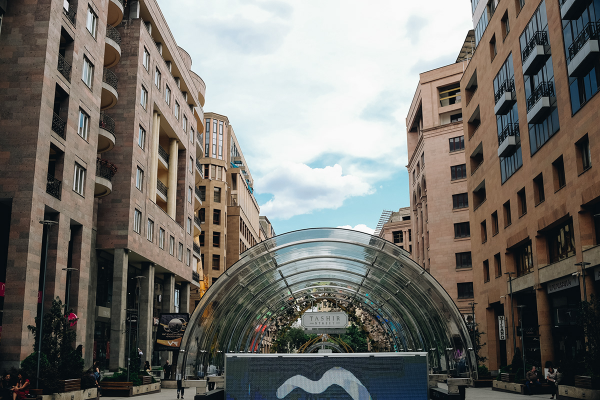
Northern Avenue is a pedestrian avenue in Yerevan, Armenia, opened in 2007. It is in the central Kentron district and links Abovyan Street with Freedom Square on Tumanyan street. It is 450 metres (1,480 ft) long and 27 metres (89 ft) wide.
Located in downtown Yerevan, the avenue is mainly home to luxurious residential buildings, high-end branded shops, commercial offices, coffee shops, hotels, restaurants, and nightclubs.
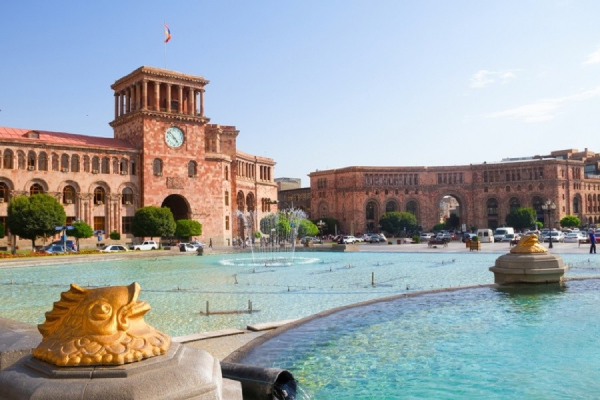
Republic Square is the central town square in Yerevan, the capital of Armenia. It consists of two sections: an oval roundabout and a trapezoid-shaped section which contains a pool with musical fountains. The square is surrounded by five major buildings built in pink and yellow tufa in the neoclassical style with extensive use of Armenian motifs.[7][8] This architectural ensemble includes the Government House, the History Museum and the National Gallery, Armenia Marriott Hotel and the ministries of Foreign Affairs and Transport and Communications. The square was originally designed by Alexander Tamanian in 1924.[9] The construction of most of the buildings was completed by the 1950s; the last building—the National Gallery—was completed in 1977.
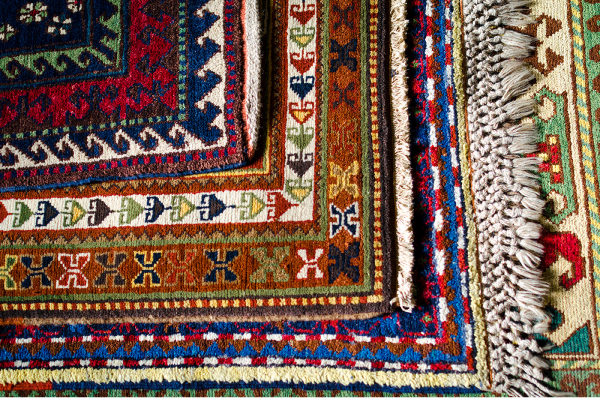
Megeryan carpet Factory – From ancient times, the carpets were a necessity in Armenians’ life. Over four generations of Megerians family have been involved in the restoration of old carpets and in the production of new ones. Nearly thirty years ago, the Megerians family began carpet reproduction, which is based on the principles of the old-style carpet appearance retention. Over time, they developed a way of get natural dye for rugs and reproductions of old technology node, which created “the loom to create their own decorative rugs”. The traditional production of handmade carpets had a fresh start. Megerians opened former and new branches in 22 areas of Armenia. In Armenia, Megeryans successfully introduced natural dyeing methods. They get the natural colors from the Armenian Plateau, flowers, roots and plants, just like it was done thousands of years ago.
Megeryans expanded production of carpets in Armenia by recreating special carpets of Vaspurakan, Karabakh, Lori and other regions through contemporary design skills. The company has a large gallery, which organizes free visits to both locals and tourists. Here you can find different carpets, purchase them, see the production process, learn about dyeing with natural materials and processing technologies.
Duration, 4-5 hours, dist.- 20-25km
Day 3 / Arche of Ararat, Garni Temple, Geghard monastery

Garni Temple – The ancient temple of Garni refers to the first century AD and is a magnificent example of architecture of the Hellenistic period. The temple is surrounded by ruins of a compound of temples, baths and palaces, accompanying the summer residence of Armenian kings from 3rd century BC of the 4th century.
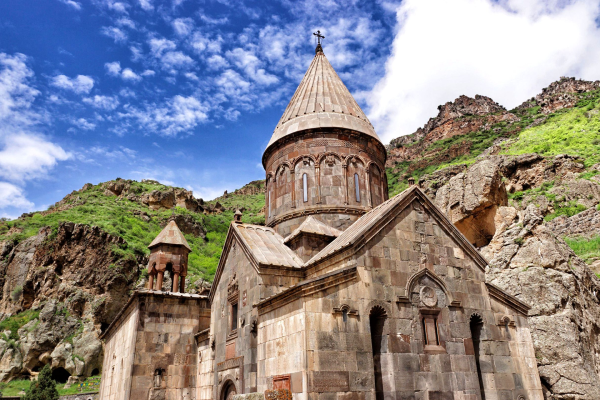
Geghard monastery – Gegard Monastery is a stunning monument of medieval Armenian architecture: part of it is carved in the rock. The monastery is registered on the World Cultural Heritage List of UNESCO. The monastery was founded in the 4th century by St. Gregory the Illuminator, and at first called Ayrivank – “Cave Monastery”. The part of the Monastery that reached our days dates back to the 12th – 13 centuries. Geghard monastery is known as the Monastery of the Seven Churches and Forty Altars. The cells of monks and tombs of the princes were also curved into the rocks
Duration 4-5 hours, dist. 90-95km
Day 4 / Etchmiadzin, St. Hripsime Church,St.Gayane Church, Etchmiadzin Cathedral

Echmiadzin – is the religious capital of Armenia, and is located 19 km west of Yerevan: the city was founded in the 4th century BC as a fortress. The Cathedral of Echmiadzin, one of the oldest existing Christian cathedrals in the world. Next to it is the residence of the Catholicos of All Armenians. The temple was founded by the first Catholicos of All Armenians – St. Gregory the Illuminator in 303 AD after he was Jesus Christ himself with a golden hammer, pointing at the place where the Temple of God had to be built. “Etchmiadzin” in Armenian means the Descent of the Only-Begotten. The monastery also includes the Theological Academy built in the 17th – 19th centuries, the Synod, the monastic monks’ cells and a library. Theological Academy is a unique institution of the Armenian Apostolic Church, where its future ministers are trained. In the courtyard of the monastery there are beautiful cross stones of various ages, including cross-stone “Saviour” from 1279 and cross-stones the from 17th-century cemetery of Old Jugha, which is now located outside of Armenia. In the Treasury of the Holy Echmiadzin relics and articles of church plate of the Armenian Apostolic Church are found. An important shrine of Echmiadzin is the Holy Lance, which is said to be holding the blood of Jesus Christ himself. It was brought to Armenia by the Holy Apostle Thaddaeus, and was originally kept in the Monastery of Geghardavank. In Echmiadzin stores particles of the Life-Giving Tree and the Sand Cross of Christ , a particle of Noah’s Ark, which God sent to the bishop Hakob Mtsbnetsi on the slopes of Mount Ararat in the 4th century, as well as the particle the crown of thorns of the Saviour. In the treasury are also relics of St.John the Baptist, St. Stephen Protomartyr, the Apostles Thaddeus and Bartholomew and Thomas, the great saints of the Christ’s Church. The Echmiadzin Church of Holy Hripsime is dedicated to one of thirty-seven Roman women who were tortured to death for their faith. Other martyrs were Gayane and Mariane: temples in their honor were also erected in Echmiadzin. The Cathedral, the Churches of St Hripsime and St. Gayane are registered in the Cultural Heritage Site of UNESCO. In Echmiadzin seminary Komitas, the great genius of Armenian spiritual music.
Duration 4-5 hours, dist. 60-70km




